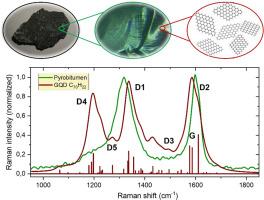通过拉曼、X 射线和理论分析揭示焦沥青和霰石碳的纳米结构性质
IF 3.1
Q2 MATERIALS SCIENCE, MULTIDISCIPLINARY
引用次数: 0
摘要
利用 X 射线粉末衍射和多波长拉曼光谱表征碳质地质材料,通过将法国布列塔尼洛佩雷茨金矿床的稀有焦沥青(LP)样品与卡累利阿闪长岩(KS)和碳同素样品进行比较,首次对其进行了纳米结构分析。根据 X 射线衍射图样得出,LP/KS 的垂直间距 d(002) 分别为 3.57(1)/3.48(1) Å,晶体厚度 Lc(002) 和石墨化程度分别为 1.4/2.0 nm 和 6.9/13.1。拉曼频带解旋显示石墨畴尺寸为 La = 6.7/8.2 nm,石墨烯类薄片曲折度 Lt = 9.2/11.3 nm。对各种二维纳米薄片进行的大量密度泛函理论计算准确地预测了 D 和 G 拉曼带可能来自石墨烯量子点,它们构成了这些土工材料纳米结构的一部分。与 KS 相比,LP 表现出更大的结构无序性,同时密度较低(1.60 vs. 1.85 g/cm³),这表明石墨化程度较低,可能是由于在较低的温度(∼300 °C)下形成的。据信,洛佩雷茨热沥青是富含二氧化碳的氧化热液与当地碳氢化合物源相互作用的氧化还原过程的结果。本文章由计算机程序翻译,如有差异,请以英文原文为准。

Unveiling the nanostructured nature of pyrobitumen and shungite carbons through Raman, X-ray and theoretical analyses
X-ray powder diffraction and multi-wavelength Raman spectroscopy were employed to characterize carbonaceous geomaterials, offering the first nanostructural analysis of rare pyrobitumen (LP) samples from the Lopérec gold deposit in Brittany, France, by comparing them to Karelian shungite (KS) and carbon allotropes samples. The inter-reticular distances d(002) for LP/KS, derived from X-ray diffraction patterns, are 3.57(1)/3.48(1) Å, with crystal thickness Lc(002) and graphitization degree of 1.4/2.0 nm and 6.9/13.1, respectively. Raman band deconvolution indicates graphitic domain sizes of La = 6.7/8.2 nm and graphene-like flake tortuosity Lt = 9.2/11.3 nm. Extensive density functional theory calculations on various 2D nanoflakes accurately predict that the D and G Raman bands may originate from graphene quantum dots, which form part of the nanostructure of these geomaterials. LP exhibits greater structural disorder than KS, along with a lower density (1.60 vs. 1.85 g/cm³), suggesting a lower degree of graphitization, likely due to formation at a lower temperature (∼300 °C). The Lopérec pyrobitumen is believed to result from a redox process involving a CO2-rich, oxidizing hydrothermal solution interacting with a local hydrocarbon source.
求助全文
通过发布文献求助,成功后即可免费获取论文全文。
去求助
来源期刊

Carbon Trends
Materials Science-Materials Science (miscellaneous)
CiteScore
4.60
自引率
0.00%
发文量
88
审稿时长
77 days
 求助内容:
求助内容: 应助结果提醒方式:
应助结果提醒方式:


